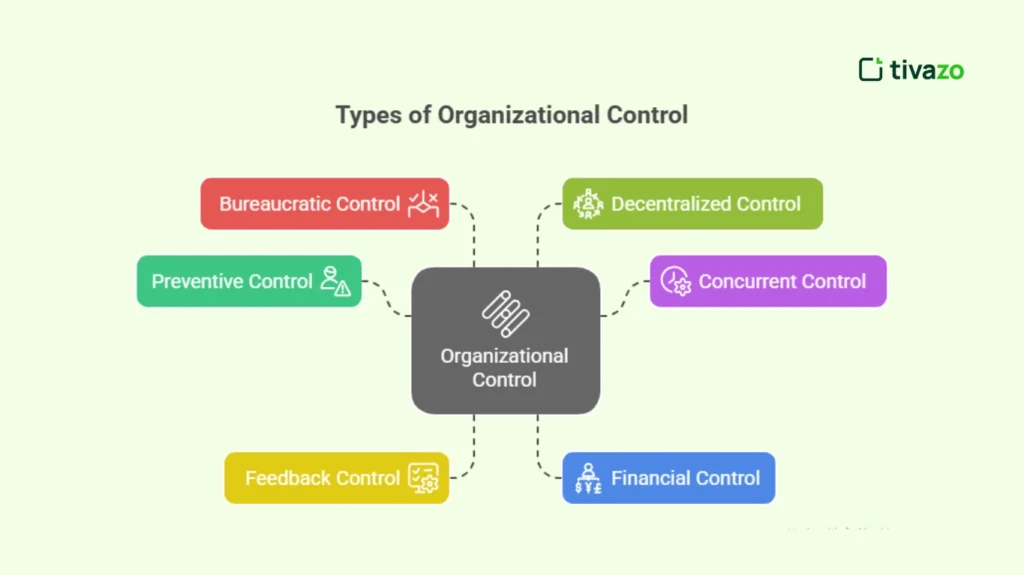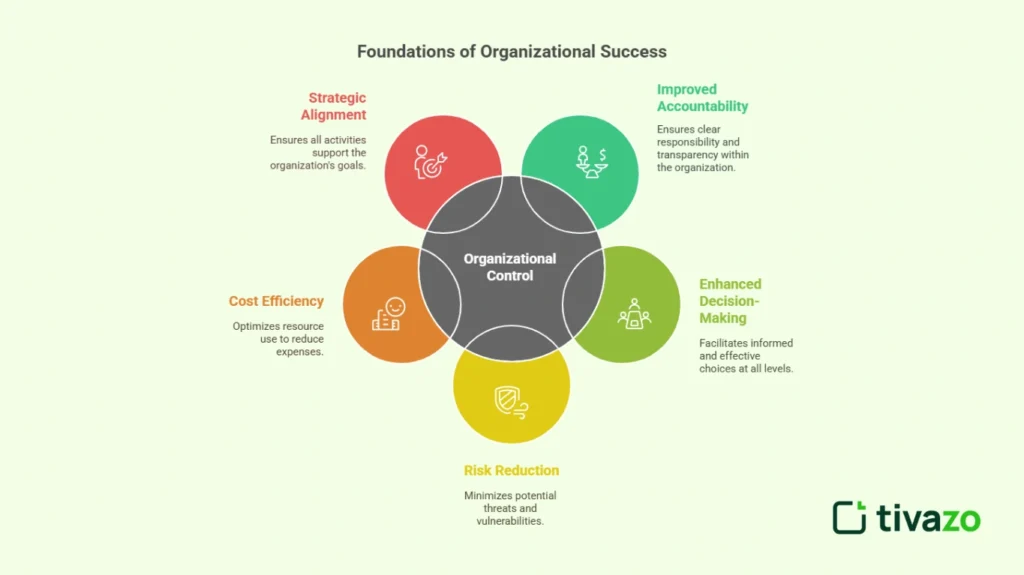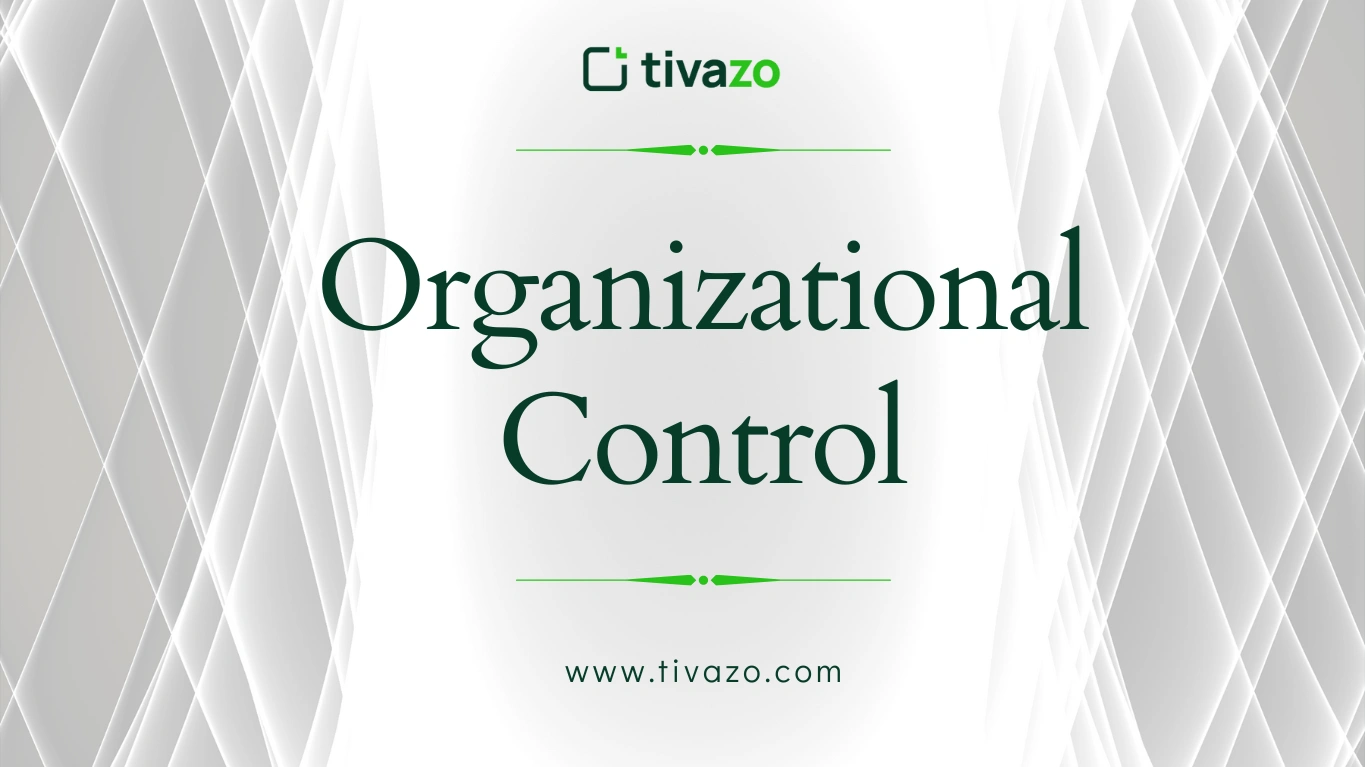Think of the situation when you are piloting a plane with no navigation systems or flying in a storm in a blind mode. That is how to manage a business without organizational control. In the case of B2B companies that have to balance out numerous layers of operations, heterogeneous workforces, and expansive models, control is not something you can afford not to have; it is strategy.
In this in-depth resource, we are going to investigate what organizational control is, why it is important in the modern competitive B2B environment, what types of control systems are used, what they offer, and how to construct an effective, custom structure for your company and its growth needs.
What is Organizational Control?
In its most fundamental aspect, organizational control refers to the means by which the firms observe the process, direct the process, and correct the process toward strategic objectives. This is how the leadership achieves its goal of ensuring that the employees work in accordance with what is expected of them with regard to the standards and performance levels of the company.
Organizational control is like a compass; it guides businesses. It ensures the safety of accountability. Regardless of whether the watchdog is financial, quality control, regulatory checks, or productivity, organizational control does it.
Why Organizational Control Matters in B2B
Organizational control is used in a B2B setting, where transactions are not only intricate but the relationships with customers are also long-term, using consistency, reliability, and trust. This is the reason why it cannot be ignored:
- Operational consistency: Can relate to making output more consistent between departments.
- Risk Mitigation: recognizes and stops deviations from plans as early as possible.
- Regulatory Compliance: Policies should be in line with the industry.
- Performance Optimization: Monitors in real-time agile enhancement measures.
- Client Confidence: A client will trust a predictable consistency of service.
Types of Organizational Control

A smart control system cannot be designed without the knowledge of the various forms of organizational control.
1. Preventive Control (Feedforward Control)
The proactive organizational control is called feedforward control. It is concerned with the discovery and implementation of the possible difficulties prior to their development.
Comparing it to putting a GPS on before a NAVIGATION of the road you are going to take, you plan out the route and prepare for the being some bad weather or bypass construction on the road before you even depart.
How it works:
- Breaks down inputs, assumptions, and systems beforehand.
- Establishes quality standards as well as benchmarks prior to the processes.
- It decreases the likelihood of failure by addressing a possible risk beforehand.
B2B Use Cases:
- Quality Assurance Protocols: Quality signatures are established in front of the manufacturer.
- Pre-Project Risk Assessments: Relating and addressing hazards as early as possible.
- Recruitment age, and Indotrination: Ensuring the new recruits can fit into the culture and objectives.
Feedforward organizational control used in B2B environments enables companies to have adequate brand credibility and consistency at the initial contact point.
2. Concurrent Control (Real-Time Control)
Concurrent control takes place through an activity or a process. It keeps operations on track according to the target as work progresses instead of allowing things to get derailed.
It means keeping your preferred direction, like driving a car, making detours, circumventing the traffic jams, or reducing your speed when you see speed limits.
How It Works:
- Is results-oriented.
- Makes it possible to take corrective actions in real-time.
- It is often based on live dashboards or reporting systems, or personal supervision.
B2B Use Cases:
- Real-time Monitoring: Monitor real-time performance metrics.
- Time Tracking Tools: Keep track of employee activity and sales.
- Mid-Meeting Adjustments: Rotate the course in the midst of the ongoing conversation of strategy.
Simultaneous organizational control is imperative in high-speed B2B teams, where success comes to those who are nimble and quick.
3. Feedback Control (Ex Post Control)
Feedback control sets in, when a task or project has been done. It is simple, both retrospective and evaluative, being interested in analyzing results and using the information to better performance in the future.
This is your post-flight analysis- what did not go well, what did and how to make it better next time.
How It Works:
- Comparison results to starting objectives.
- Determines trend, error, or inefficiency.
- Assists in streamlining the process in terms of organized learning.
B2B Use Cases:
- Post-Mortem Project Reviews: The payoff of a client campaign.
- Customer Feedback Analysis: Can assist in the formulation of products/services.
- Financial Audits: Determine the profitability, the usefulness of the budget.
Feedback organizational control is strong in B to B since it helps in the closing of the gap between strategy and action, leading to improvement that is continuous.
4. Financial Control
Financial control is one of the most practical and tangible organizational controls, though it guarantees that a business is utilizing its resources economically and is profitable.
Just imagine it is your fuel gauge in your car, you should watch the spending rate, otherwise, you will have the collapse of the car.
How It Works:
- Monitors earning, spending, ROI, and money metrics.
- Aids in the keeping of businesses on budgets and investing.
- Enables that financial mismanagement or leakage is detected early.
B2B Use cases:
- Budget variance reports: Identify where expenditure differs to the projections.
- ROI Tracking: Confirm marketing or structure investment.
- Profit Margin Analysis: Find profitability of the various clients or verticals.
In large or medium-sized B2B companies where many revenues are involved, the financial organizational control is tough to provide a solid foundation for the decision-making process based on facts and the budget-dependent reality.
5. Bureaucratic Control
A typical model of organizational control is founded on the top-down organizational design, well defined rules, and guarded systems.
Characteristics:
- Centralized decision-making.
- A lot of reliance on policy and procedures.
- Non-tolerance of deviation.
B2B Case Uses:
- Governed Industries: Medical, Financial, and Manufacturing.
- Risk-Avoidant Enterprises: In this case, compliance is the most important.
Order and standardization created by a bureaucratic form of organizational control is ideal in industries in which a minor error can have catastrophic effects.
6. Decentralized Control
In this contemporary method, the decision-making is among teams. It promotes independence, faith, and quicker innovation, particularly in cross-functional, agile B2B teams.
Characteristics:
- Multiple Level employee empowerment.
- More dependence on self-management.
- Promotes ideas, adaptability, and quicker implementation.
B2B Use cases:
- Tech Startup and SaaS Companies: Where speed of iteration is of importance.
- Innovation Labs or Creative Agencies: At these workshops, independent thinking drives innovation.
A hybrid approach with a bureaucratic system of control used in areas of compliance and finance, and taking a decentralized system of control in the areas of R&D, sales, and marketing has become a common method of operation for many B2B businesses.
Benefits of Organizational Control

An effective organizational control system does not qualify as a mere formality of management but is a growth driver that contributes to operational excellence and long-term success. To take a closer look at the benefits of organizational control in modern B2B companies, it is worth discussing the following areas:
1. Improved Accountability
Organizational control comes in to enhance a culture of accountability that includes clarity of roles, expectations, and level of performance. Employees will take ownership of their work when they know what to do, and when they know that their output will be tracked without any prejudices. It should especially be emphasized in a B2B setting, where delays, lack of appropriate communication, or poor quality may negatively affect the satisfaction of the clients and the long-term contracts. Through accountability, organizations have minimized a lot of errors made by teams as well as individuals to enhance their performance.
2. Enhanced Decision-Making
Decision-making can also be more informed and strategic, given that the key data and insight into performance are made available due to organizational control systems. Leaders do not need to make decisions only based upon intuition; they may also use real-time metrics and evaluate trends, determine problems and discover new opportunities. Data-driven insights will become invaluable in the B2B sector where much of the intelligence can determine whether long-term partnerships are a success or failure, or even the outcome of highly valued accounts.
3. Risk Reduction
Among the fundamental values of an organizational control lies the fact that it allows early detection and prevention of risks. The companies can detect any imminent problem in its early stage before they become difficult problems after conducting monitoring of the processes, financial activities, and employee behaviors. Such pro-active strategy is essential to those B2B firms which have to deal with regulations, cost audit, and customer service level agreements. An effective control mechanism prevents the organization against various compliance violations, fraud, or loss of reputation.
4. Cost Efficiency
Organizational control systems can assist a company allocate its resources in an ideal way because of reduced wastefulness and efficiency in the running of its operations. Be it saving the expended resources on unnecessary items, be it learning how to manage time, or avoid wasting time and efforts on repeat actions, the control mechanisms allow channeling each and every penny and hour of time productively. In the case of B2B companies, profit margins are usually soldierly associated with the use of resources, this efficiency is directly transferred to increased profitability and the better return on investment.
5. Strategic Alignment
Through the relationship of daily activities to long-term strategic plans, organizational control serves the purpose of guaranteeing that each department and team is involved in the overall mission of the company. It helps in maintaining the employees on target regarding the major goals and eliminates the chances of misalignment associated with disparate work. When it comes to B2B organizations, however, where functions, such as sales or customer support, are required to interact and operate cohesively, this alignment is a way to ensure they receive the stable brand experience and growth.
What Makes an Effective Organizational Control System?
Organizational control is not micromanaging. It is a balance. The main elements of an effective control system are the following:
1. Clear Objectives
Appropriate control commences with understandable aims. When the objectives are aligned to the business strategy, then it becomes easier to measure the success and get the teams to implement the desired outcomes.
2. Transparent Metrics
Real and actionable KPIs, as opposed to vanity metrics, help to correctly report performance and list improvement based on useful information.
3. Two-Way Feedback Loops
The control systems must promote both downward and upward flow of communication keeping the managers updated and the employees listened to.
4. Flexible Systems
The good control system is flexible. Flexibility enables businesses to adapt to moving markets and within itself without losing control.
5. Technology Integration
Using dashboard and automation tools helps to enhance the accuracy of work, minimize the manual effort and bring real-time visibility among workgroups.
Organizational control works because it manages to be adaptable to change and remain structured at the same time.
Tech Tools That Enhance Organizational Control in B2B
Technology makes a difference. Such tools render the deployment of organizational control to be effective and scalable:
| Tool | Function |
| Tivazo | Real-time productivity and attendance tracking |
| Asana | Task and workflow monitoring |
| HubSpot | CRM and sales process control |
| QuickBooks | Financial control and forecasting |
| Slack + Pulse Bots | Culture and employee sentiment monitoring |
Intelligent B2B executives not only watch, but they also implement technology to make their companies effectively controlled over the long run.
KPIs to Monitor Organizational Control
1. Employee Productivity Scores
This KPI is used to determine the effectiveness of the performance of employees in completing of their tasks and within their places of operation. When the scores of high productivity are recorded, it is likely to signify the organizational control that is leading to focus and accountability in the teams.
2. Budget Variance
Monitoring of the planned and actual spending can determine the effectiveness of financial control. Small variances are associated with high discipline in budgeting, and high gaps might imply poor alignment or monitoring.
3. Customer Retention Rate
Retention is an indicator as to the degree at which internal controls facilitate comfortable service provision and customer satisfaction. Retention in B2B is normally a good sign that an operations is reliable and trusted.
4. Compliance Incident Rate
The KPI measures how often the policy is violated, there are regulatory problems, or internal rules have been broken. Lower levels indicate that the controls in compliance are clear, put into effect and comprehended across the company.
5. Project Timeline Accuracy
By tracking the completion rate of projects, it is possible to determine which teams are keeping plans and how effective the workflows are being done. Proper schedules show a healthy implementation and planning.
Conclusion: Organizational Control as Your Strategic Weapon
A competitive environment of B2B requires business to look further than their gut instincts. They require organizational control not to put down but nourish them and grow.
It is not red tape. It involves a redirecting process. An effective control system coordinates your personnel, systems and mission.
Therefore, when you are creating a future B2B company, then the question to ask is:
Has your organizational control been in your favor, or against you?




